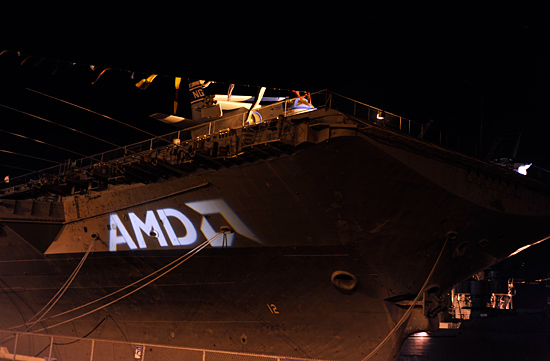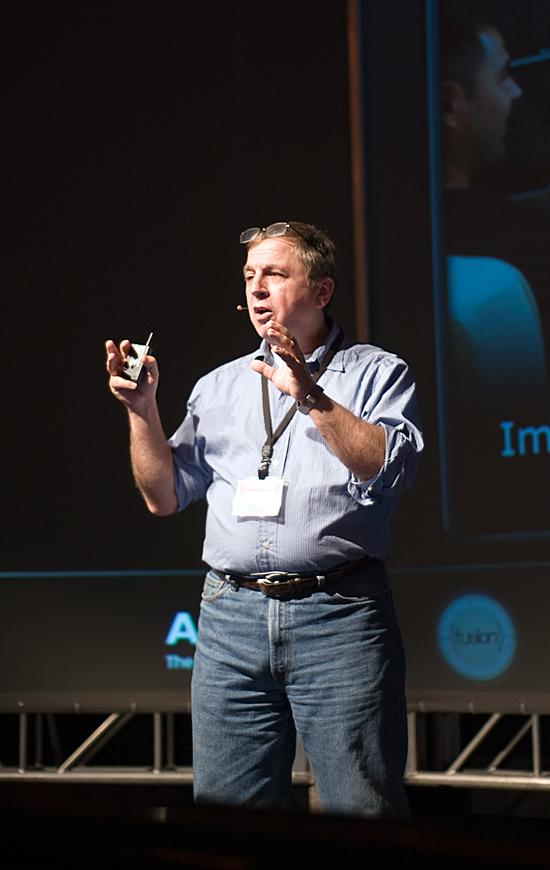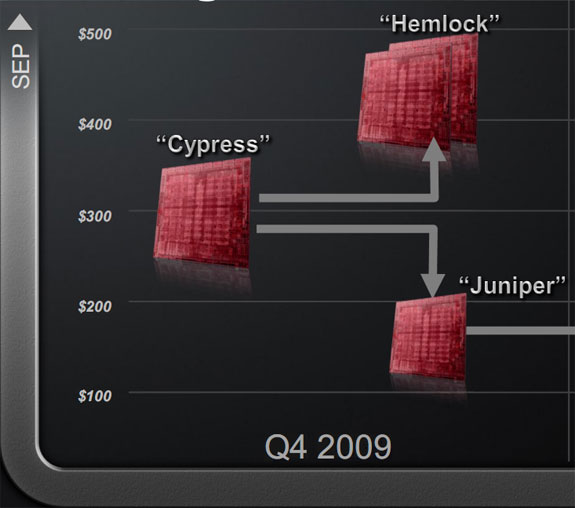The RV870 Story: AMD Showing up to the Fight
by Anand Lal Shimpi on February 14, 2010 12:00 AM EST- Posted in
- GPUs
The Call
My love/hate relationship with AMD PR continued last year. But lately, it’s been far less hate. Let’s rewind back to the Summer of 2009. I’d been waiting for AMD to call for weeks.
We all knew that the RV870 was going to launch sometime before the end of the year, and we’re normally briefed on new GPUs around a month or so before we get hardware. The rumors said that the launch had been pushed back, but just like clockwork I got a call in June or July of last year. It was my old friend, Chris Hook of AMD PR.

This time he wanted me to come to a press event on a carrier off the coast of California. Sigh.
It’s not that I have anything against carriers. It’s just that all I cared about at that time was the long awaited successor to the RV770. The RV770 was the GPU that unequivocally restored my faith in ATI graphics, an impact shared by others last June. But that’s not how the game is played I’m afraid. AMD promises its management and its partners that they can fill a room (or carrier) up with important press. We get promised access to engineers, useful information and free drinks.

The USS Hornet. GPUs are in there.
I’m not easily swayed by free drinks, but Chris Hook knows me well enough by now to know what I’d appreciate even more.
The Dinner - September 2009
I had to leave dinner earlier than I wanted to. ASUS’ Chairman Jonney Shih was in town and only had one opportunity to meet me before I left Oakland. Whenever either of us happens to be in the same town, we always make our best effort to meet - and I wasn’t going to let him down. In the same vein that Steve Jobs is successful because he is a product guy at heart, running a company best known for its products. Jonney Shih is an engineer at heart, and he runs a company who has always been known for their excellence in engineering. This wasn’t just another meeting with an executive, this was a meeting with someone who has a passion for the same things I do. His focus isn’t on making money, it’s on engineering. It’s a rare treat.
My ride was waiting outside. I closed the lid on my laptop, making sure to save the 13 pages of notes I just took while at dinner. And I shook this man’s hand:

Before I left he asked me to do one thing. He said “Try not to make the story about me. There are tons of hardworking engineers that really made this chip happen”. Like Jonney, Carrell Killebrew has his own combination of traits that make him completely unique in this industry. All of the greats are like that. They’ve all got their own history that brought them to the companies that they work for today, and they have their own sets of personality traits that when combined make them so unique. For Carrell Killebrew it's a mixture of intelligence, pragmatism, passion and humility that's very rare to see. He's also a genuinely good guy. One of his tenets is that you should always expect the best from others. If you expect any less than the best, that’s all you’ll ever get from them. It’s a positive take on people, one that surprisingly enough only burned Carrell once. Perhaps he’s more fortunate than most.
Mr. Killebrew didn’t make the RV870, but he was beyond instrumental in making sure it was a success. What follows is a small portion of the story of the RV870, the GPU behind the Radeon HD 5800 series. I call it a small portion of the story because despite this article using more than eight thousand words to tell it, the actual story took place over years and in the minds and work of hundreds of engineers. This GPU, like all others (even Fermi) is the lifework of some of the best engineers in the industry. They are the heroes of our industry, and I hope I can do their story justice.
As is usually the case with these GPU backstories, to understand why things unfolded the way they did we have to look back a few years. Introducing a brand new GPU can take 2 - 4 years from start to finish. Thus to understand the origins of the Radeon HD 5800 series (RV870) we have to look back to 2005.
Sidebar on Naming
AMD PR really doesn’t like it when I use the name RV870. With this last generation of GPUs, AMD wanted to move away from its traditional naming. According to AMD, there is no GPU called the RV870, despite the fact that Carrell Killebrew, Eric Demers and numerous others referred to it as such over the past couple of years. As with most drastic changes, it usually takes a while for these things to sink in. I’ve also heard reference to an RV870 jar - think of it as a swear jar but for each time someone calls Cypress an RV870.

Why the change? Well, giving each member of a GPU family a name helps confuse the competition. It’s easy to know that RV870 is the successor to the RV770. It’s harder to tell exactly what a Cypress is.
AMD PR would rather me refer to RV870 and the subject of today’s story as Cypress. The chart below shows AMD’s full listing of codenames for the 40nm DX11 GPU lineup:
| GPU | Codename |
| ATI Radeon HD 5900 Series | Hemlock |
| ATI Radeon HD 5800 Series | Cypress |
| ATI Radeon HD 5700 Series | Juniper |
| ATI Radeon HD 5600/5500 Series | Redwood |
| ATI Radeon HD 5400 Series | Cedar |
Given that we still haven’t purged the RVxxx naming from our vocabulary, I’m going to stick with RV870 for this story. But for those of you who have embraced the new nomenclature - RV870 = Cypress and at points I will use the two names interchangeably. The entire chip stack is called Evergreen. The replacement stack is called the Northern Islands.










132 Comments
View All Comments
Spoelie - Thursday, February 18, 2010 - link
phoronix.comfor all things ATi + Linux
SeanHollister - Monday, February 15, 2010 - link
Fantastic work, Anand. It's so difficult to make pieces like this work without coming across as puffery, but everything here feels genuine and evenhanded. Here's hoping for similar articles featuring individuals at NVIDIA, Intel and beyond in the not-too-distant future.boslink - Monday, February 15, 2010 - link
Just like many others i'm also reading/visiting anandtech for years but this article made me register just to say damn good job.Also for the long time i didn't read article from cover to cover. Usually i read first page and maybe second (enough to guess what's in other pages) and than skip to conclusions.
But this article remind us that Graphic card/chip is not only silicon. Real people story is what makes this article great.
Thanks Anand
AmdInside - Monday, February 15, 2010 - link
Great article as usual. Sunspot seems like the biggest non-factor in the 5x00 series. Except for hardware reviews sites which have lots of monitors lying around, I just don't see a need for it. It is like NVIDIA's 3D Vision. Concept sounds good but in general practice, it is not very realistic that a user will use it. Just another check box that a company can point to to an OEM and say we have it and they don't. NVIDIA has had Eyefinity for a while (SLI Mosaic). It just is very expensive since it is targeted towards businesses and not consumers and offers some features Eyefinity doesn't offer.I think NVIDIA just didn't believe consumers really wanted it but added it afterwards just so that ATI doesn't have a checkbox they can brag about. But NVIDIA probably still believes this is mainly a business feature.It is always interesting to learn how businesses make product decisions internally. I always hate reading interviews of PR people. I learn zero. Talk to engineers if you really want to learn something.
BelardA - Tuesday, February 16, 2010 - link
I think the point of Eyefinity is that its more hardware based and natural... not requiring so much work from the game publisher. A way of having higher screen details over a span of monitors.A few games will actually span 2 or 3 monitors. Or some will use the 2nd display as a control panel. With Eyefinity, it tells the game "I have #### x #### pixels" and auto divides the signal onto 3 or 6 screens and be playable. That is quite cool.
But as you say, its a bit of a non-factor. Most users will still only have one display to work with. Hmmm. there was a monitor that was almost seamless 3-monitors built together, where is that?
Also, I think the TOP-SECRET aspect of Sun-Spots was a way of testing security. Eyefinity isn't a major thing... but the hiding of it was.
While employees do move about in the business, the sharing of trade-secrets could still get them in trouble - if caught. It does happen, but how much?
gomakeit - Monday, February 15, 2010 - link
I love these insightful articles! This is why Anandtech is one of my favorite tech sites ever!Smell This - Monday, February 15, 2010 - link
Probably could have done without the snide reference to the CPU division at the end of the article - it added nothing and was a detraction from the overall piece.It also implies a symbiotic relationship between AMDs 40+ year battle with Chipzilla and the GPU Wars with nV. Not really an accurate correlation. The CPU division has their own headaches.
It is appropriate to note, however, that both divisions must bring their 'A' Game to the table with the upcoming convergence on-die of the CPU-GPU.
mrwilton - Monday, February 15, 2010 - link
Thank you, Anand, for this great and fun-to-read article. It really has been some time where I have read an article cover to cover.Keep up the excellent work.
Best wishes, wt
Ananke - Monday, February 15, 2010 - link
I have 5850, it is a great card. However, what people saying about PC gaming is true - gaming on PC slowly fades towards consoles. You cannot justify several thousand-dollar PC versus a 2-300 multimedia console.So powerful GPU is a supercomputer by itself. Please ATI, make better Avivo transcoder, push open software development using Steam further. We need many applications, not just Photoshop and Cyberlink. We need hundreds, and many free, to utilize this calculation power. Then, it will make sense to use this cards.
erple2 - Tuesday, February 16, 2010 - link
Perhaps. However, this "PC Gaming is being killed off by the 2-300 multimedia console" war has been going on since the Playstation 1 came out. PC gaming is still doing very well.I think that there will always be some sort of market (even if only 10% - that's significant enough to make companies take notice) for PC Gaming. While I still have to use the PC for something, I'll continue to use it for gaming, as well.
Reading the article, I find it poignant that the focus is on //execution// rather than //ideas//. It reminds me of a blog written by Jeff Atwood (http://www.codinghorror.com/blog/2010/01/cultivate...">http://www.codinghorror.com/blog/2010/01/cultivate... if you're interested) about the exact same thing. Focus on what you //do//. Execution (ie "what do we have an 80%+ chance of getting done on time) is more important than the idea (ie features you can claim on a spec sheet).
As a hardware developer (goes the same for any software developer), your job is to release the product. That means following a schedule. That means focusing on what you can do, not on what you want to do. It sounds to me like ATI has been following that paradigm, which is why they seem to be doing so well these days.
What's particularly encouraging about the story written was that Management had the foresight to actually listen to the technical side when coming up with the schedules and requirements. That, in and of itself, is something that a significant number of companies just don't do well.
It's nice to hear from the internal wing of the company from time to time, and not just the glossy presentation of hardware releases.
I for one thoroughly enjoyed the read. I liked the perspective that the RV5-- err Evergreen gave on the process of developing hardware. What works, and what doesn't.
Great article. Goes down in my book with the SSD and RV770 articles as some of the best IT reads I've done.